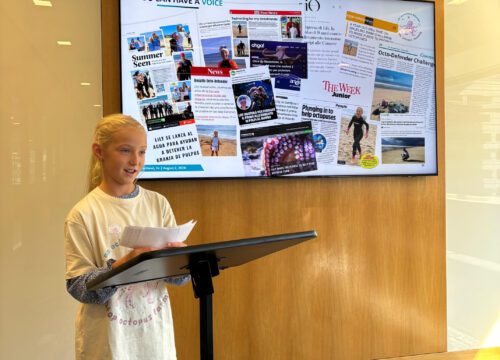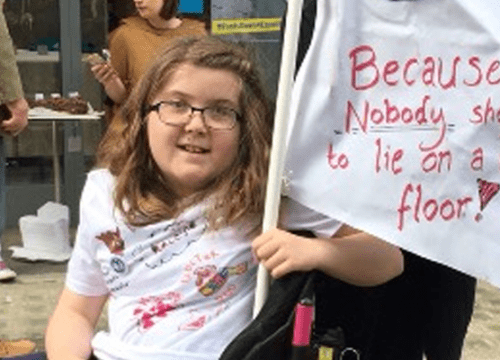Raising money and awareness for octopus protection since she was 10 years old.
Petitioning
Signing A Petition
Petitions are written requests to change something. They are like a letter which is signed by as many people as possible to show that lots of people feel the same way. They are addressed to people who have the power to make the change in the relevant area, so they are often addressed to the government but can be made to other public bodies such as councils or schools or even to a business that you want to see make a change.
A petition can be about anything, from asking your local council to fix up the park, to asking your school to offer vegan meals.
The more people that sign it, the more those receiving it will realise that lots of people care about the issue being written about.
With our step-by-step guide to petition, it’s easy to create a petition about something you care about. And if you make an effort to spread the word, you could have thousands of people sign it!
Did you know that if 100,000 people sign a petition on the UK government website, it must be discussed in parliament?! That means that the government will definitely hear about it and must respond!
Steps to signing a petition

1. Choose what petition you would like to sign.
You may already have one in mind or you might want to find one. If you want to browse existing petitions, take a look at the UK Government petition website.

2. Sign the petition.
You will be required to enter your name, email and postcode.
 Always talk to your parent or guardian before you give personal information away on any website.
Always talk to your parent or guardian before you give personal information away on any website.

3. Share the petition.
Talk to your friends and family to encourage them to sign the petition too! Remember – the more signatures, the more likely change is to happen!
 Ask your parent or guardian to help you share the petition on social media.
Ask your parent or guardian to help you share the petition on social media.
Steps to making a petition

1. Choose what you want your petition to ask for.
Be clear what change you’re asking for. For example, you can ask for a law to be changed to stop harmful behaviour, like companies releasing sewage into water. Or you could ask for a change of behaviour, such as for a business to stop using single use plastics.

2. Create your petition.
There are online petition tools that you can use to easily start a petition. These are useful to easily share your petition via email or social media. If your petition is aimed at the government, you can use the special UK Government Petition website.
Alternatively, you can make your petition as a physical letter and collect signatures from people in person.
Remember to keep your petition short and clear: explain what you want to change and why you want to change it. It is always a good idea to get someone else to proofread it before you send it out.

3. Sign the petition.
You will be required to sign the petition before it launches. Enter your name, email and postcode.
 Always talk to your parent or guardian before you give personal information away on any website.
Always talk to your parent or guardian before you give personal information away on any website.

4. Share the petition.
Talk to your friends and family, encouraging them to sign the petition, as well! With parent or guardian permission or help, you could also share it on social media. The petition needs five signatures before it goes live.
 Ask your parent or guardian to help you share the petition on social media.
Ask your parent or guardian to help you share the petition on social media.

REFLECT
Petitioning is not only a great way to make change happen but it’s also a great way to develop your persuasive writing and speaking skills.
Don’t forget to have a think about what went well, what you might have learnt for the future, and the impact of your actions.
For example, did you get the number of signatures that you needed to make change happen? Did you learn anything about how to approach people and share your views?
A petition that changed the world
One petition that changed the lives of all future women in Australia and the world is the ‘Women’s Right to Vote Petition.’
In September 1891, a handful of dedicated women took to the streets to fight to gain the right to vote for all women in Victoria (a state in Australia). They went from door to door to collect signatures, resulting in an impressive 30,000 signatures. They had so many signatures that the paper scroll reached 260m long and had to be rolled onto a cardboard rod!
The petition played an important role in securing women’s right to vote. And, in 1901, Australia led the way, becoming the first nation in the world to give women both the right to vote and the right to stand in parliament.

Change-Makers
Petitions can be an effective way to show governments that many people are requesting the same change. Check out some change-makers who used petitions to make an amazing difference to the world:
Ali Waters Galán
Campaigning for people and businesses to stop using single-use plastics since they were 10 and 12 years old.
Amy and Ella Meek
Campaigning for people and businesses to stop using single-use plastics since they were 10 and 12 years old.
Callum Isted
Petitioning for schools to give children reusable water bottles since he was 7 years old.
Melati and Isabel…
Campaigning for the banning of plastic bags in Bali since they were 10 and 12 years old.











